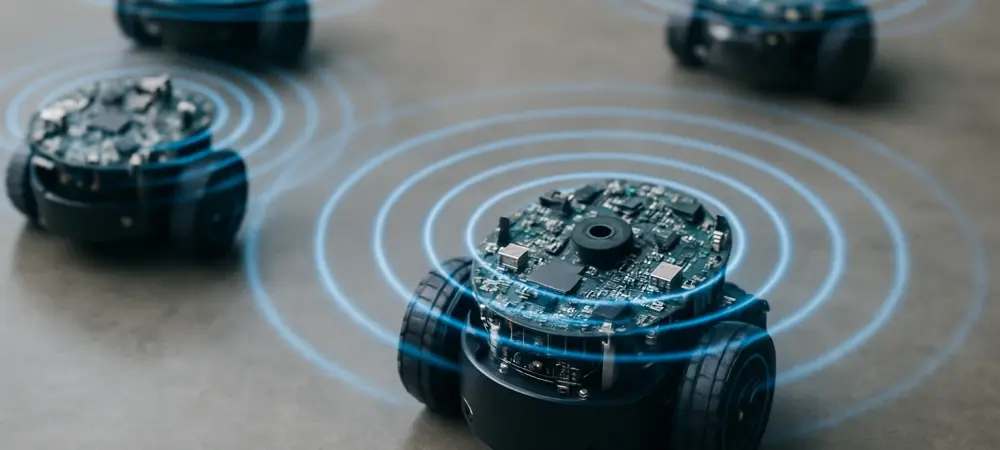Swarm robotics has emerged as a groundbreaking field, introducing innovative ways to manage transport in multiple industries. At the forefront of this revolution is a novel approach developed by researchers at University College London (UCL), who employ sound waves to enable the seamless, contactless movement of small items. These swarm robots, inspired by the coordinated behavior of ants, utilize ultrasonic transmitters and receivers to suspend and convey objects without touching them, promising significant advancements in sectors ranging from healthcare to manufacturing.
Industry Overview
The swarm robotics industry is rapidly evolving due to the integration of sound wave technology in transport systems. Swarm robots, capable of autonomous operation and cooperation, are reshaping traditional transport methods. With the ability to execute complex tasks like load management and obstacle avoidance autonomously, these robots reduce reliance on human intervention. Key industry players are continuously innovating, making significant strides in robot communication techniques through acoustic signaling. This technology is crucial for applications in sensitive areas such as medical environments, where minimizing human contact can mitigate infection risks and enhance precision in microassembly tasks.
Industry Trends and Market Dynamics
Technological Advancements and Trends
The landscape of swarm robotics is characterized by rapid technological advancements, particularly in acoustic signaling. This emerging technology has opened new possibilities for precise, non-invasive interaction between robots, allowing for enhanced coordination and control. As consumer demands evolve, these innovations pave the way for opportunities in sectors demanding high levels of autonomy and precision, like healthcare and delicate manufacturing processes. The ability of these robots to operate without direct contact is poised to transform operational landscapes, offering safer and cleaner environments through sound-based navigation and transport.
Market Data and Growth Projections
Recent market data indicates robust growth in the swarm robotics sector, buoyed by advancements in communication and transport technologies. Analysts project significant expansion over the next few years, driven by increased demand for automation and efficiency. Current trends suggest a shift towards systems that replace traditional robotic methods with more autonomous, collective approaches. The use of sound wave technology is expected to play a pivotal role in driving growth, as it aligns with broader industry goals of maximizing productivity while minimizing human intervention.
Challenges and Complexities
Despite the promising outlook, the swarm robotics industry faces several challenges, primarily related to the technological limitations inherent in sound wave-based systems. The current capabilities are confined to transporting small items, restricting their application to certain areas. Additionally, market adoption hurdles persist as industries adapt to integrating these novel systems into existing processes. To mitigate these issues, researchers and developers are focusing on enhancing acoustic signaling capabilities and expanding the load capacity of these robots. Strategic partnerships and collaborations are crucial in overcoming these barriers.
Regulatory Environment
The regulatory framework for swarm robotics, especially regarding sound wave technology, is still evolving. As the technology advances, industry players must navigate complex regulations that govern compliance and security measures. Adhering to these regulations is vital for ensuring the safety and reliability of swarm robotics applications. These compliance measures also play a significant role in shaping industry practices, as companies must align their operations with evolving standards to facilitate smooth adoption across sectors.
Future Outlook
Looking ahead, the swarm robotics industry stands on the brink of further innovation and disruption. Emerging technologies and new market entrants are set to redefine traditional operational paradigms. There is a growing trend toward increased automation and real-time decision-making capabilities within robotic systems, which will likely spur further market expansion. As consumer preferences shift towards more efficient and autonomous solutions, areas such as healthcare and precision manufacturing are poised for transformation, with sound wave technology at the heart of these advancements.
Conclusion and Recommendations
In conclusion, the swarm robotics sector is undergoing a transformative phase, driven by the integration of sound wave technology in transport applications. The industry is geared for significant growth, with acoustic signaling allowing for seamless, non-contact transport solutions. To capitalize on this growth, stakeholders should focus on technological enhancements and regulatory compliance. Expanding capabilities to accommodate heavier loads and fostering strategic partnerships will be crucial for unlocking new opportunities and ensuring sustained industry advancement.

